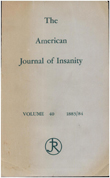Remembering the past: two facets of episodic memory explored with positron emission tomography
Abstract
OBJECTIVE: This study used positron emission tomography to examine two kinds of personal memory that are used in psychiatric evaluation: focused episodic memory (recall of past experience, employed in "taking a history") and random episodic memory (uncensored thinking about experience, examined during analytic therapy using free association). For comparison, a third memory task was used to tap impersonal memory that represents general information about the world ("semantic memory"). METHOD: Thirteen subjects were studied using the [15O]H2O method to obtain quantitative measurements of cerebral blood flow. The three conditions were subtracted and their relative relationships examined. RESULTS: The random episodic condition produced activations in widely distributed association cortex (right and left frontal, parietal, angular/supramarginal, and posterior inferior temporal regions). Focused episodic memory engaged a network that included the medial inferior frontal regions, precuneus/retrosplenial cingulate, anterior cingulate, thalamus, and cerebellum. The use of medial frontal regions and the precuneus/retrosplenial cingulate was common to both focused and random episodic memory. The major difference between semantic and episodic memory was activation of Broca's area and the left frontal operculum by semantic memory. CONCLUSIONS: These results indicate that free-ranging mental activity (random episodic memory) produces large activations in association cortex and may reflect both active retrieval of past experiences and planning of future experiences. Focused episodic memory shares some components of this circuit (inferior frontal and precuneus), which may reflect the time- linked components of both aspects of episodic memory, and which permit human beings to experience personal identity, consciousness, and self- awareness.
Access content
To read the fulltext, please use one of the options below to sign in or purchase access.- Personal login
- Institutional Login
- Sign in via OpenAthens
- Register for access
-
Please login/register if you wish to pair your device and check access availability.
Not a subscriber?
PsychiatryOnline subscription options offer access to the DSM-5 library, books, journals, CME, and patient resources. This all-in-one virtual library provides psychiatrists and mental health professionals with key resources for diagnosis, treatment, research, and professional development.
Need more help? PsychiatryOnline Customer Service may be reached by emailing [email protected] or by calling 800-368-5777 (in the U.S.) or 703-907-7322 (outside the U.S.).



